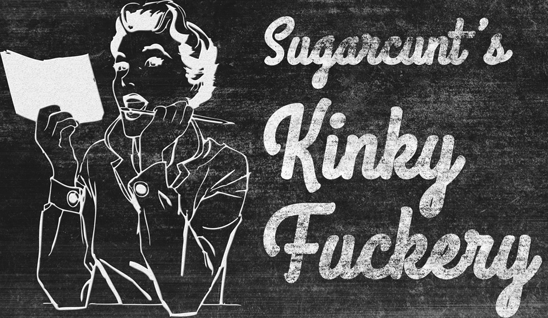Kinky Fuckery 101: Models of Consent
I wrote several pieces about kink approximately two years ago when I was writing for GetLusty, but it occurred to me recently that I don’t think I’ve ever really addressed kink for beginners here on my blog. I realize that some of my readers are vanilla, some are seasoned BDSM practitioners, and some of you may consider yourself kink-curious.
If you’re kink-curious you might have thought about light bondage in the past, or may have a fantasy that revolves around servitude. Maybe you have sexy dreams where you boss people around and punish them for misbehavior. Maybe you’ve read 50 Shades of Grey (god help you) and your interest was piqued. To the kink-curious among you: The Kinky Fuckery series is dedicated to you.
Models of Consent
Before I start talking about the glory of being tied down and tormented, I want to talk first about the importance of consent. Since you don’t live in a bubble I hope you are familiar with the idea of sexual consent by now, and while consent can be very complex the bottom line is as simple as this: “No” means no. “Ouch” probably means no. “Don’t” means no. “Stop” means no.
The reason I feel like it’s so important to recap basic rules of consent is that when you’re in an agreed-upon BDSM scene, “no,” “ouch,” and “don’t,” and sometimes “stop” may not always explicitly mean no. Maybe you said “no” because you’re playing the reluctant submissive who wants to be coerced. Maybe you happily bent over for a flogging because you like the pain but you said “ouch” because… duh, it hurts, but you like that.
Toggling Consent
Consent is ongoing. All participants in sexual activity have the right to revoke consent at any time, and once consent is revoked the activity stops. In BDSM your safeword is generally your consent toggle. If you’re gagged, always hold something in your hand, ideally something that will make noise (like keys), that you can drop if you hit the safeword point. The minute you say or drop your safeword you are revoking your consent. You are telling your partner to stop, that you are either done with that particular activity or that you need to talk to them to re-negotiate how you two are doing it. More on that later.
Informed Consent
Before you even get to the point where you’ll need a safeword, you and your partner need to establish informed consent. Informed consent means that you know exactly what you’re agreeing to. Talk about everything that everyone involved wants to do during this scene and what your limits are. Be sure that you bring up things that may trigger you so your partner can avoid them. Make sure that if you’re using acronyms when negotiating that all partners know what they stand for. You don’t want your partner to agree to a WAM scene online and then be shocked when you start pelting them with pudding. The idea of informed consent is that all parties understand what will be done and what those activities entail.
SSC and RACK
SSC stands for “Safe, Sane, and Consensual,” a commonly-known tenet among BDSM practitioners that is pretty straightforward: all partners must be of sound mind and consensually agree to participate safely in an activity. The concept of SSC is good, but the current popular interpretation is kind of iffy.
The first problem with SSC is that the word “sane” is pretty ableist. Plenty of us in the BDSM world have mental disorders that may not classify us as “sane,” but we are still capable of consent and that shouldn’t disqualify us from playing. The word makes some of us feel alienated. It’s also very subjective – the activities that one player might consider “sane” may differ wildly from another player, and I think that leaves a lot of room for people to get judge-y. One could argue that wanting to be beaten or degraded in the first place probably isn’t “sane”. What I find that most people interpret “sane” to mean is that participants shouldn’t be under the influence of drugs or alcohol, and I agree with that.
It’s easy to get carried away or make regretful decisions when you’re under the influence, and drugs and alcohol may dampen your pain receptors, which might seem like a good idea if you’re looking to get beaten, but can easily work against you. If you can’t feel what’s being done to you, you risk severe injury. It’s the same reason that you shouldn’t use numbing lubricants.
The second problem is that many kinky people don’t like “safe” activities. While “safe” was initially coined to indicate ethical play, many people have begun to associate the word “safe” with “risk-free.” That’s not really feasible for BDSM anyway because most S/M activities are never 100% guaranteed to be safe, much like anything else in life. The popularity of the “risk-free” idea puts a good portion of kinky people out on their asses, because many of us enjoy edge play, which is play that generally straddles the line of SSC. Edge play is a term that is somewhat subjective, but encompasses activities that have the potential to be pretty dangerous: asphyxiation, knife play, gun play, fire play, cutting, branding, needle play, and blood play.
Many people greatly prefer the acronym RACK: “Risk-Aware Consensual Kink.” In addition to not containing any loaded, subjective, or ableist terminology, it acknowledges that all activities come with risk and nothing is completely safe. Within the RACK framework the spectrum of activity does not go from safe to unsafe – instead, it goes from safer activities to less safe activities.
Safewords and Stoplights
My safeword with my previous partners is “bananaphone.” Find a word that will probably never come up in the context of your play and designate it as your safeword. Safewords are a vital part of BDSM and are all too often overlooked by people who have no idea what they’re doing. I recommend you pick a safeword that is short, or at least one word, instead of two.
As I stated earlier, your safeword is a consent toggle. If you only designate one safeword that means no then that word means “stop this right now.” It doesn’t always mean that the scene has to end for good, but the activity occurring needs to stop. Maybe your ass is too tender to take more spankings. Maybe you can’t emotionally handle being called a cumdumpster any more tonight. Maybe something triggered you and EVERYTHING needs to stop. Whatever the reason for pausing or stopping, always have a safeword to ensure that you can do it. Do not ever fear using your safeword, because it’s there to protect you.
Some people say they don’t want safewords because they are afraid they’ll use them too soon, or because they prefer to take on the role of slave and desire the feeling of total powerlessness to fulfill their fantasies. All I can do is tell you that you need one, no matter who you are. If you’re afraid of using your safeword too soon, why? If you think it’s time to use your safeword then that’s when you need to use it. It’s not like saying your safeword has to kill the scene. It can always start back up. If you’re interested in serving as a slave, would you still be content doing everything your master said if they started disregarding your hard limits? What if they told you that you’d never be disciplined again? Would you still want to play? Safewords are intended to interrupt the fantasy, however briefly, because they’re telling your partner that reality needs attention.
If you prefer a method of safewording that is short and to the point, try the stoplight system. “Red” works the same way a regular safeword does; it’s a full stop. “Yellow” indicates that you might need to discuss some things, may need something to change, or may be reaching your limit. And obviously “green” is GO, GO, GO!
Checking In
As a bottom, you need to be proactive about voicing your limits, and as a top you need to be proactive about checking in with your bottom. If you’ve been whipping your masochist a little while it’s okay to check in with them, and you don’t even have to break character to do it. If your submissive is being very quiet, check in with them to make sure they haven’t fallen deep into subspace. You want to make sure that your partner continues to consent to what you’re doing throughout the scene, because you absolutely don’t want to hurt someone more than they want to be hurt. You can do this as simply as saying, “How are you doing?” It’s the decent thing to do, and while you may not want to be a nice top, surely you want to be a decent one.
Got something to say about consent? Insight into safewords? Share with us! Leave a comment below so we can learn more.









